
James Pearson has made a rare repeat of the highball 8A+ boulder 29 Dots in Valle dell'Orco, Italy.
The boulder, which stands at forty-five feet, and has a crux just over halfway up, was first climbed by Bernd Zangerl in 2015. Zangerl inspected the route on abseil, and worked out some individual sequences whilst on top rope, before climbing the route in its entirety for the first time without ropes. Prior to James' ascent, it had received just a single repeat, that of bouldering World Cup winner, 8C boulderer, and 9b lead climber, Gabriele Moroni in 2017.
James sent through a write up of his experience on the boulder, shared below:
Last week, Caro and I headed with the kids to Valle dell'Orco in Italy, for Caro to attempt Green Spit, the famous roof crack. I didn't have any particular objective, as I was mainly there to look after the kids and give her as much time as she wanted, but I couldn't help being drawn to an amazing overhanging arete just sitting there in the middle of the main car park. This arete is called '29 Dots', and it was originally climbed by the Austrian bouldering legend Bernd Zangerl in 2015.
For anyone who knows Bernd's resume, when he says "29 Dots is the proudest, the hardest piece of rock I climbed in this style. A great moment, and a highlight in my bouldering career," it has to be pretty special! Repeated only once by Gabri Moroni, another incredible climber who has climbed 8C, 9b and won bouldering World Cups, 29 Dots is spoken of in almost hushed tones of disbelief because not only is it really hard, but also really, really high!
The videos you can see online of Bernd and Gabri on the route really do not do it justice! Firstly, they are both filmed from far away, and directly behind the route, so you can't see the size of the holds or the impressive overhang. Secondly, both climbers are world-class monsters, so they are able to make 8th grade bouldering look like a relative walk in the park. All this makes a very impressive bit of rock and some very scary climbing actually look pretty tame, and when I first saw videos of the climb, I thought it looked like a good possibility for attempting ground up – how wrong could I be!
When you first see the route first hand you can't help being impressed. The arete overhangs by a few metres, and from the floor you can barely see any holds. The chances of being able to climb up this amazing feature without bolts seems very slim. After a first session on the route in unseasonably hot weather, the route didn't seem any easier, and although I managed to scrape my myself up most of the individual moves, they all felt so hard that I couldn't imagine having the power and fitness to link them together, let alone doing them above that sort of a fall. The Fontainebleau 8A crux is at 6 metres, which is scary enough, but there is still another hard section above that with powerful and insecure moves. The route eventually tops out at 14 metres, which to put things into context is almost the same height as Harder Faster at Black Rocks, one of the boldest and most dangerous routes I've ever done!
The one redeeming factor for 29 Dots is that the landing is perfectly flat, which definitely makes the initial boulder section more amenable, however, a fall from the upper section will be bad regardless.
I know there is a lot of ambiguity in the term "Highball", not to mention that its use is very subjective, but I'd personally say that if you can't fall off something it is no longer a boulder problem, and I'd definitely consider 29 Dots a solo. If I had made the first ascent I'd have given it an E Grade, but that's easy for me to say having grown up in the UK, and having a reasonable understanding of that crazy grading scale! Whether we use an E Grade, a sport grade, or a boulder grade, I think it's important to make clear that this is not just a highball boulder problem with an inconsequential easy scramble to get to the top. There is hard climbing at a height where you really can't fall.
The crazy weather we are having these days saw us lose more than 20° in two days, and the next time I came back to Orco it was 5° with a strong wind blowing. With cooler conditions the moves now felt a lot more controllable, and I managed to link the crux, and then the entire line a few times on a rope. Unfortunately I was having serious problems with numb fingers, and though the upper part felt very comfortable in isolation, whenever I combined the first boulder, the tiny 'Razor Blade' crimps and Arctic like conditions drained all life from my fingertips, making the second half of the route feel significantly harder than it should.
I spent a couple of hours swinging around on a rope, improving my sequence on every attempt, but also using up precious skin and energy. I knew the smart choice was to go home, and come back fresh another day with a load of pads, but was sure that I could do it and was scared to waste these "great" conditions in case it was the last cold spell before summer.
I pulled out the precious few pads we had in the van, telling myself I was just going to boulder out the first moves to see how I felt, but knowing I was already committed. I set everything up, moved the pads a little left, a little right, trying to imagine the possible trajectory of a fall from the crux. I didn't worry about the pads for the higher section because a fall from up there was going to be bad whatever, and as such, not worth entertaining. I toproped it once more from the crux to the top to warm up my tips, came down, untied, and set off. I cruised the first few moves, feeling the tiny holds bite into my skin and sensing the exhilaration of setting out on another adventure. Everything felt really good, really solid, then suddenly I felt tired and proceeded to fall off the crux move!
You know it's a long fall when you have time to think "I hope this is going to be ok"! Thankfully I landed in the middle of the pads, tumbled onto my bum and stood back up, feeling a little shaken and mainly a little shocked to have fallen off at all. Instead of taking this for the warning sign it should have been, I guessed that my final top rope attempt just before the lead was probably a little too much and had probably tired me out. After half an hour of rest, including two kids poo stops to bring me mentally back to earth, I felt ready to try again. In the hope of feeling less fatigued on the hard lower moves, I decided to skip the warm up lap on the route itself, and to try to prepare my fingers for the upcoming punishment by simply pulling aggressively a few times on the first holds!
Writing this now I feel so stupid. This isn't my first rodeo, I know I struggle with numb fingers, and that a few tugs on some sharp holds are never enough to avoid me numbing out. I'd been struggling with numb fingers on the top section all day, so there was no logical reason that it would suddenly get better on the lead. The idea of being solo up on that top wall without any sensation in my fingers was pretty terrifying, yet for some reason I refused to acknowledge all of these warnings, and ploughed on regardless.
The lack of top rope warmup definitely gave me a little more energy, and I stuck the 7m high crux hold, though with far less margin than I would have liked. At that point, it's possible to have a quick shake on two very small but positive crimps whilst you prepare yourself for the next section, but I knew if I did that I would definitely get numb out, so decided I was going to race the numbness to the top of the route and climb straight into the second crux. Immediately when I grabbed the first left-hand hold, I knew something was wrong, I couldn't properly feel the specific spikes under my fingers, and had to force way more than necessary to move my feet into position.
The next move is in my opinion, the most dangerous move on the route, and whilst significantly easier than the lower moves, it is still around a 7A+ boulder, with your feet high up and to the side opposing your hands on two side-pulls. Whilst falling off the lower crux is not to be advised, it is a straight fall down to the mats from an up-right position. The second crux, whilst only one and a half metres higher, is from a totally different body position, and would likely see you falling sideways away from the pads, possibly onto your back! I gave a lot of my remaining energy into controlling this move, and came far too close to the edge for my liking.
From this point the climbing becomes slightly easier with every passing move, and I'd never really considered the possibility of falling from up there. It comes as no surprise that with little feeling in your fingers you waste a lot of energy in over-controlling every hold, and I found myself in the hellish position of being both pumped, and numb, and getting worse by the second. Moves that should have been easy static pulls became focused lunges, and for the first time in many years I thought about what falling off from here might feel like!
If I can take one positive thing from this whole experience, it's that I managed to stay calm when everything around me was going wrong. Fear and panic have no place on a dangerous route, and I forced those thoughts away just as quickly as they'd appeared. It sounds cliche, but at this point the only thing that mattered was getting to the top, and thankfully, even though I made a very bad decision to go for the route on this day, after hundreds of sketchy climbs, my subconscious knew what to do.
Bold routes like this one are usually a beautiful experience, where I climb in a bubble of peace and tranquillity, only to be replaced by pride and elation at the top of the route. This time unfortunately I had none of that, only fear and discomfort then sadness and shame. I topped out in silence and scolded myself for putting my family down below in such an awful position. Then, packed the van and then drove home.
I'm not sharing any of this for shock value, or as a way to try to make 29 dots seem even more scary. The route is what it is, it doesn't need me to big it up, and my experience on it is mine alone. I guess I'm telling this story partly because I'm sad at wasting the opportunity for something truly special, and if it hadn't been for my lack of patience, it could have been another wonderful trad experience of walking that fine line between risk and danger. Mainly though, I want this to be a warning to other climbers out there to always respect the rock, and pay attention to the signs. I got away with this one, but I shouldn't have had to.
You can watch footage of James' ascent in the video below:

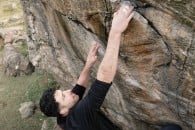

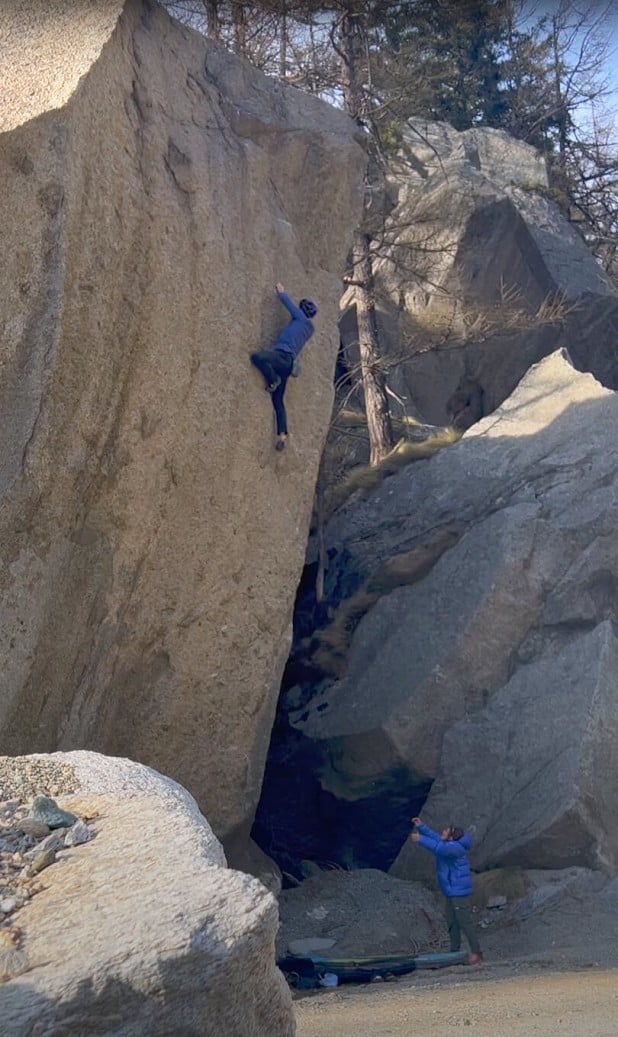
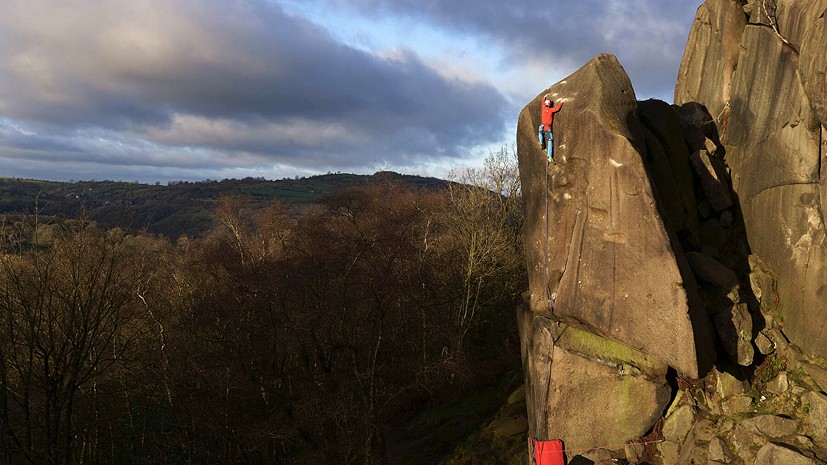
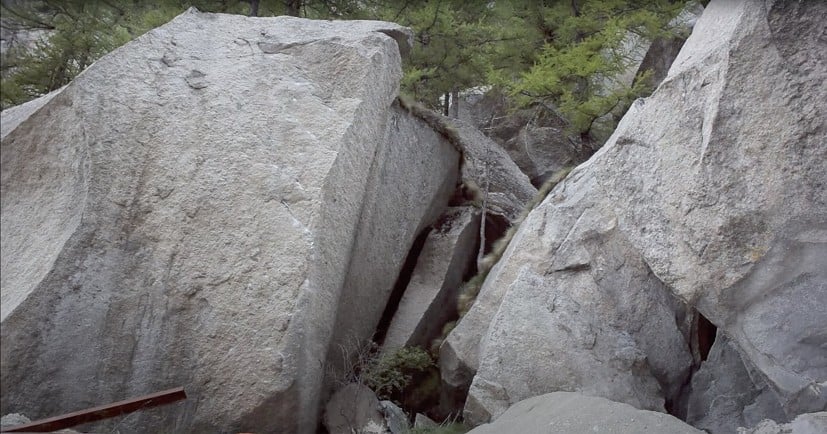
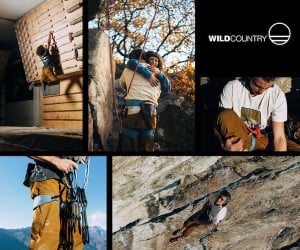


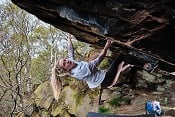

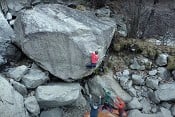
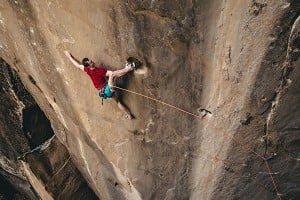
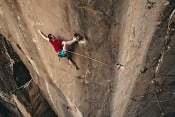
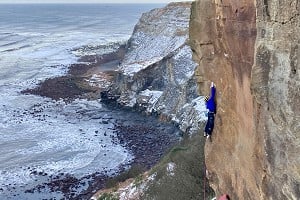

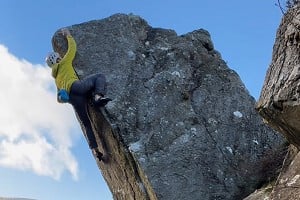
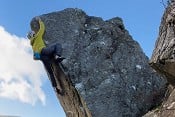

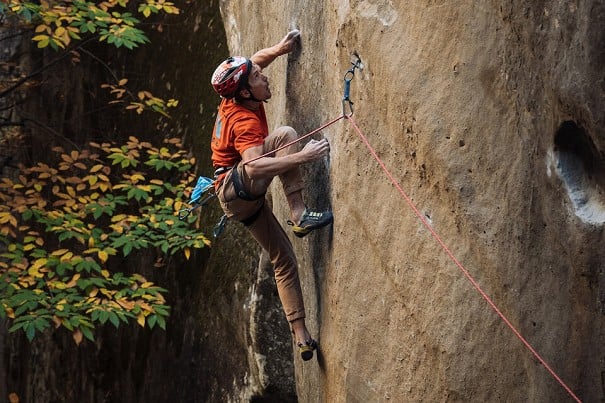
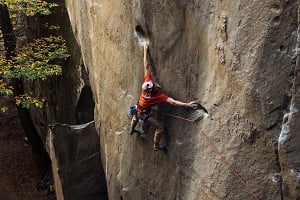
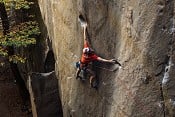
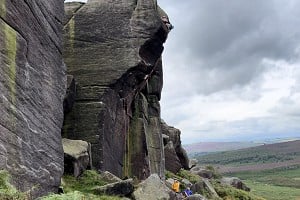
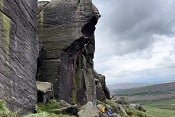
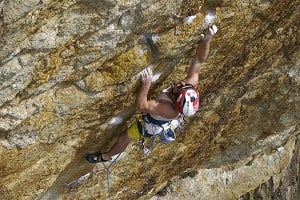
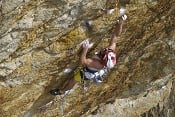

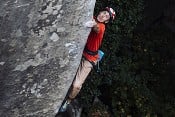
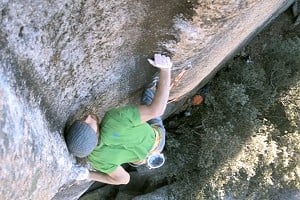

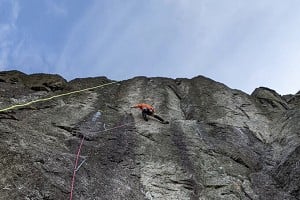
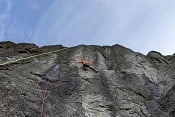
Comments
Boulder problem my arse.
Nice honest account. Definitely a very different feeling when you get to the top of something bold when you've been in control vs scared shitless!
Amazing that the FA was done ground-up, with, presumably, no knowledge of how hard the top bit was going to be.
The first ascent wasn't a true ground-up, a full ab inspection and at least a bit of toproping was involved.
From a UKC article "This year I stopped again and decided to rappel down. There were some ''safe“ crimps on the upper part of the wall. At the bottom I found some razorblade holds to start. After three goes my fingers were bleeding. After a few days of effort I was finally halfway up the wall, but I didn't find any features to get into the headwall. The 'Drop Zone' was also very close to a steel girder, lying on the ground. Some falls later I decided to check this sequence with a rope. It took me two days to find a safe solution. I put the rope away and started again ground up. A week later I made the first ascent of 29dots with the mental support of Danilo, a local from Noasca. "
Which unclearly implies that the top bit wasn't practiced.
From the angle of the trees and the spotter, it looks like the camera is off vertical, so it's actually steeper than it looks.
Really appreciate James's honesty on this as someone who has just had a similar experience (albeit at considerable lower grades) but didn't walk away (ambulance of shame for me). Sometimes it is so easy to let desire to get 'the tick' outweigh experience and good judgement.
Also if 14m is a boulder problem, Peak grit needs to have a word with itself!